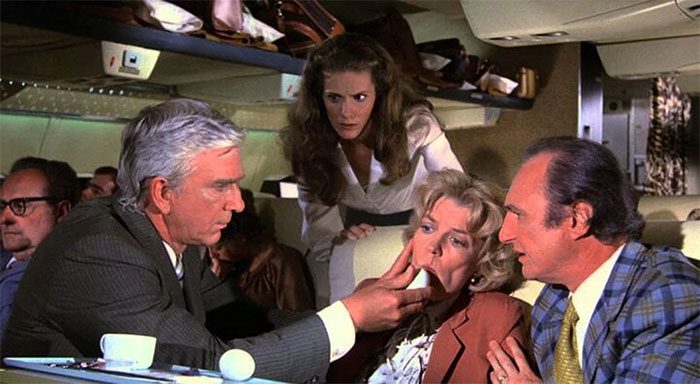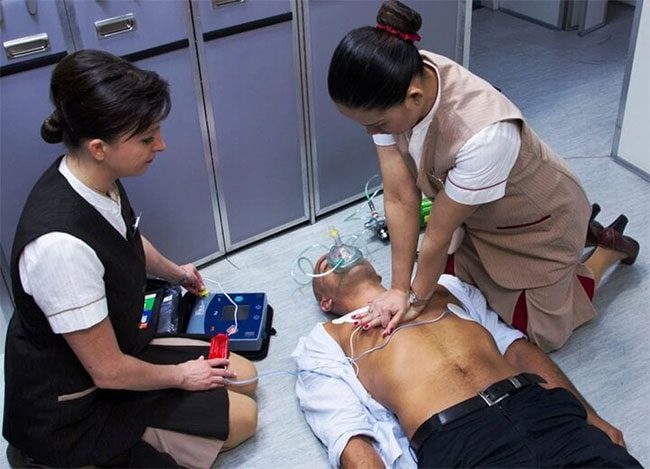When sitting on an airplane, the human body’s reaction is unpredictable due to high altitude and changing cabin pressure. In many cases, passengers may suddenly feel unwell and require assistance from the crew and medical professionals. At this point, the captain will make an announcement asking if there are any doctors or nurses among the passengers, and request their help.
Many people may wonder why there are no doctors on airplanes, despite the high risk of health issues arising, the difficulty of landing to transport a sick passenger to a hospital, and the critical need for timely medical expertise?

Why are there no doctors on airplanes, and why do crew members always ask if there are any medical personnel among the passengers? (Photo: Live and Let’s Fly)
Why There Are No Doctors on Airplanes
The answer is: The presence of a doctor on board is not mandatory, so crew members do not include a doctor.
According to Ouest France , airlines are not obligated to have medical personnel on flights, whether short or long-haul. On the other hand, crew members and pilots flying in Europe are required to undergo basic first aid training.
Since July 2008, flight attendants (commercial attendants) in Europe must hold a CFS – safety training certificate. They are required to complete at least 100 hours of theoretical training and 35 hours of practical training. To obtain this certificate, they must study a specific section on “medical aspects and first aid.”
Many other countries impose their own regulations in this area. For example, in Canada, crew members are trained in first aid and must undergo annual retraining.
In the UK, national airline attendants are trained to reassure passengers with a calm yet authoritative voice in case of an incident. Additionally, during their medical training with the airline, all staff learn essential skills such as using a defibrillator, performing artificial respiration for someone who is choking, assisting in childbirth, and cutting the umbilical cord for newborns in case of an “in-flight delivery.”
In Vietnam, flight attendants also receive similar medical training. Some staff members are even certified to use a defibrillator when necessary. Moreover, all airlines train crew members in cardiopulmonary resuscitation (CPR), assisting in childbirth, and providing first aid for common medical issues such as strokes, heart attacks, seizures, or burns.

No airplane has a doctor, but the crew is trained in basic first aid to handle emergencies. (Photo: CabinCrew24)
How Passengers Receive Medical Support Without a Doctor
Since crew members are trained in some medical skills, they can provide first aid to passengers during the flight, such as resuscitating or stabilizing a fractured limb, bandaging wounds, or assisting with stomach pain.
The captain and crew are equipped to handle potential incidents on flights, most of which are benign and related to cabin pressure or stress during travel (issues such as ear, nose, throat problems, or stomach pain).
The crew must ensure that medical equipment is available on the aircraft before takeoff. A first aid kit containing bandages, dressings, and over-the-counter medications (such as anti-nausea or pain relief medications) is designed to treat up to 100 passengers.
There is also an emergency medical kit on board, which can only be opened with the captain’s approval and in the presence of a doctor. This kit typically contains a stethoscope, syringes, tourniquets, and prescription medications (antispasmodics, bronchodilators, anticonvulsants). Each aircraft must have emergency oxygen available to assist passengers with respiratory issues during the flight.
On the other hand, equipping a defibrillator is not mandatory on flights in Europe (but it is in the United States). However, some European airlines, such as Air France, have equipped their aircraft with defibrillators and trained their staff on how to use them.
One reassuring statistic is that nearly 80% of flights have passengers who are doctors. When a passenger’s health condition exceeds the crew’s first aid capabilities, the captain will call for assistance from any doctors on board.
According to data from Air France’s medical advisor, when the crew asks “Is there a doctor on board?”, nearly 78% of the time they receive an affirmative response “yes.” This is one of the reasons why there are no doctors on airplanes.
In many countries, regulations state that in an emergency, if the captain calls for assistance and the doctors present on the flight do not respond, they may face legal consequences. In France, a doctor who refuses such a call may be prosecuted for failing to assist a person in danger and could face up to 5 years in prison and a fine of €75,000.
In the case of a medical emergency, an aircraft may be diverted to ensure the passenger receives treatment at the nearest hospital. For long-haul flights abroad, planes are often diverted to the nearest capital.




















































